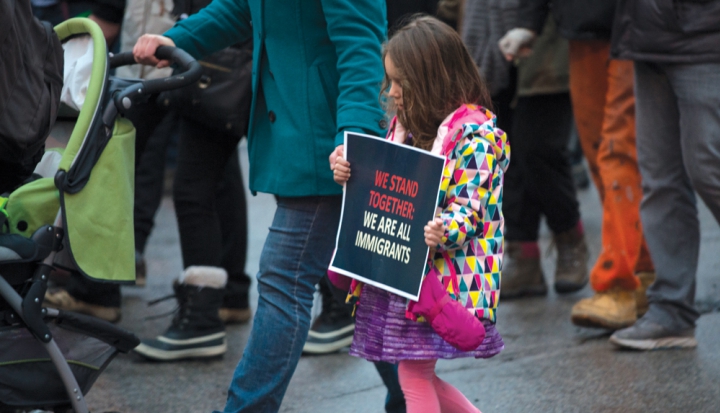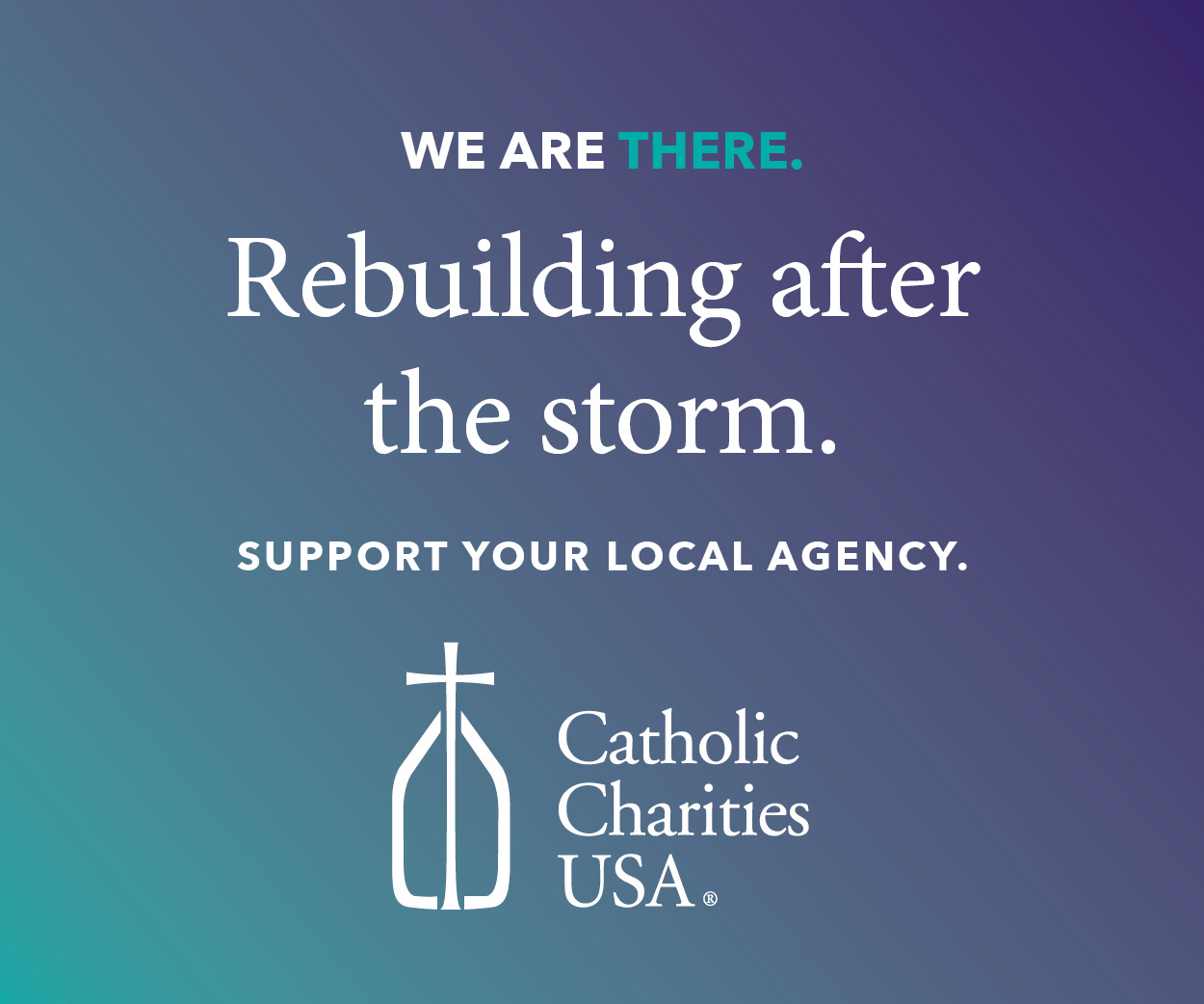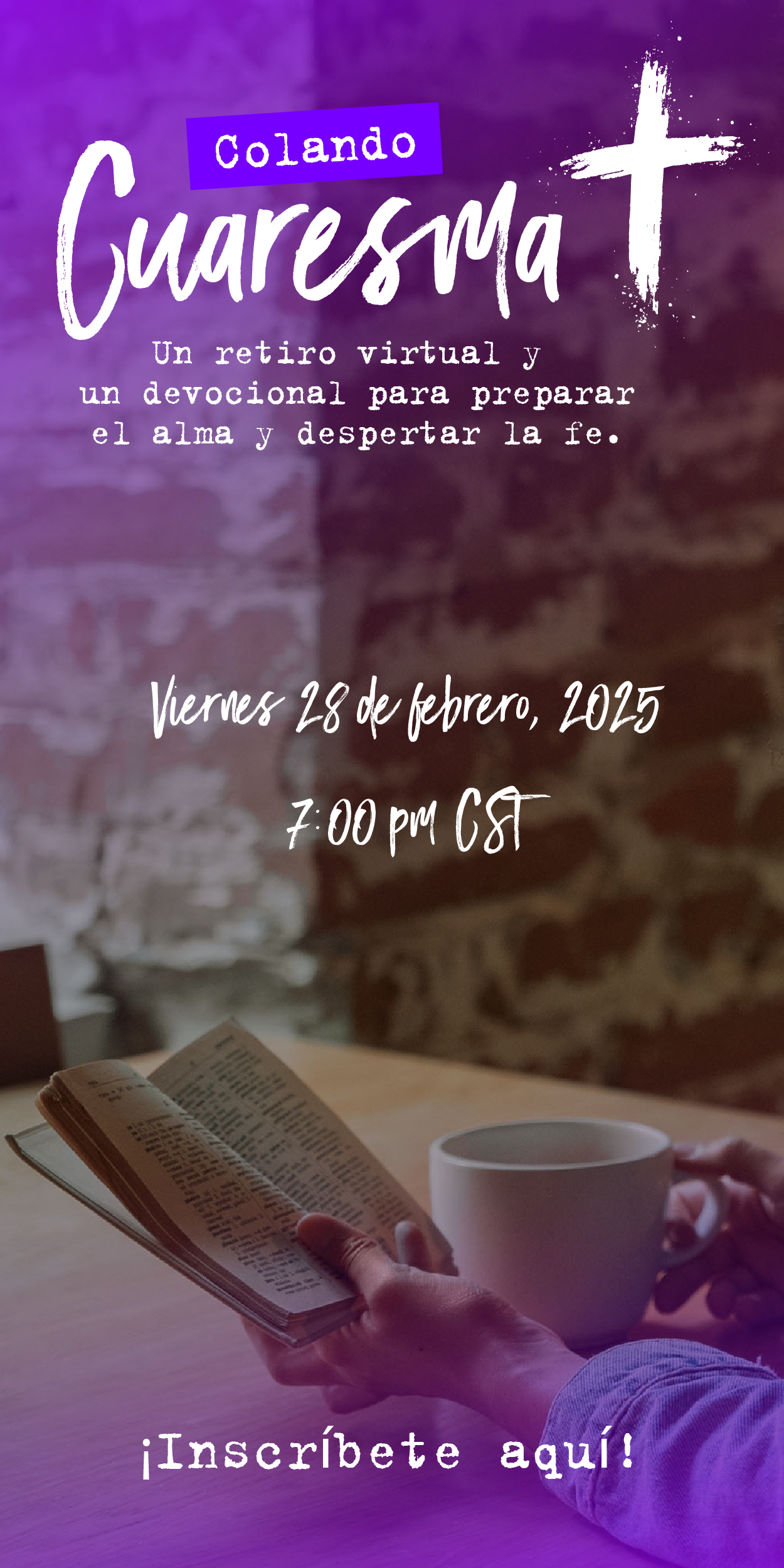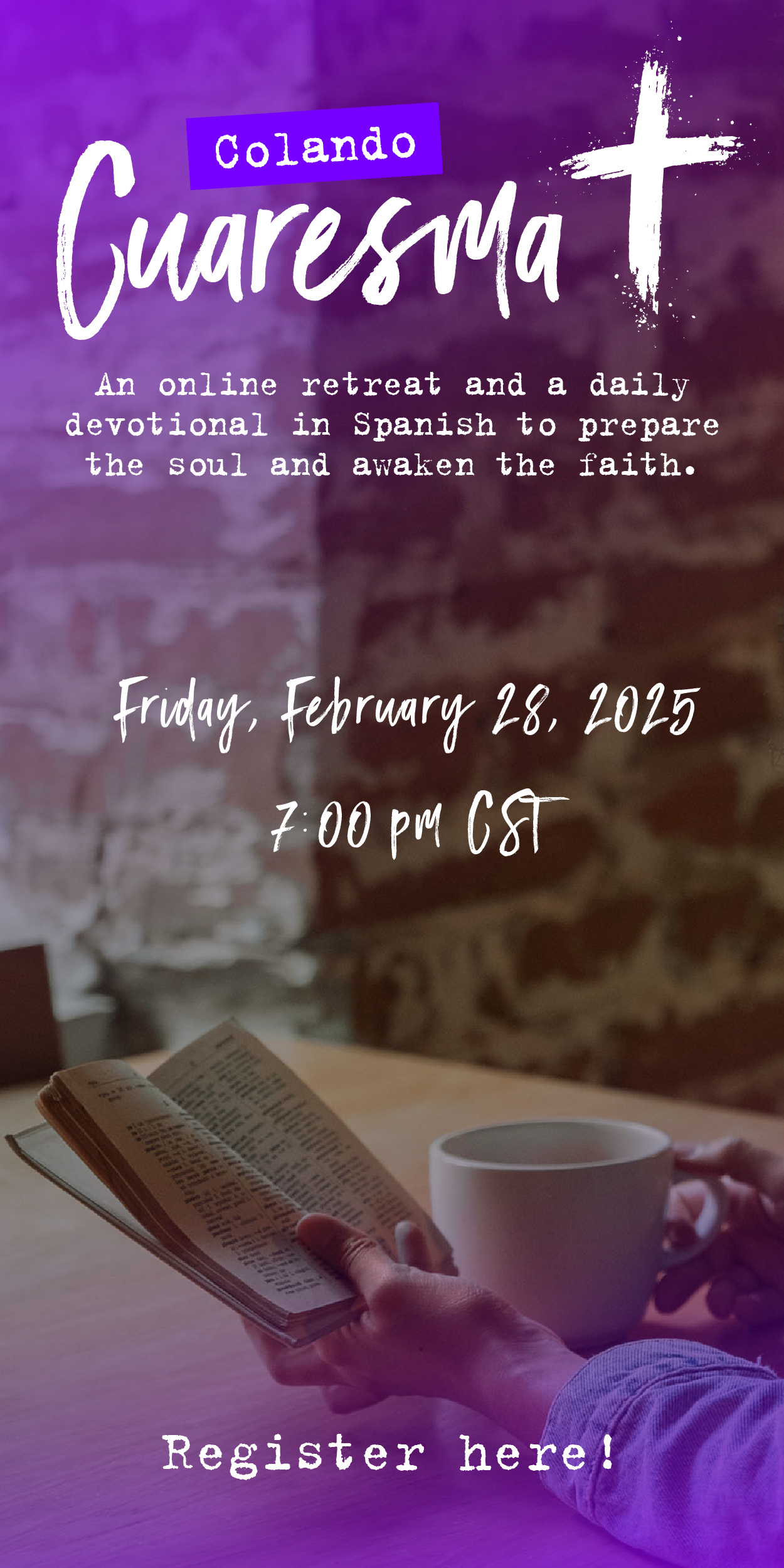One day as we were walking home from kindergarten, my 5-year-old daughter sighed loudly as a plastic bag blew past her feet on the sidewalk. “What is it?” I asked. “The oceans,” she said with a world-weary sigh. “I’m worried about all the sea creatures. Especially the whale shark.”
Turns out her class had discussed the whole plastic-bags-in-the-ocean thing and learned the meaning of the word endangered during a science lesson—and the kid was taking it to heart. “I think our whole family should put on gloves and go around and pick up all the trash in our neighborhood,” she said. Not only did she have a complaint, she also had an idea for a solution. Her instinct for action inspired me.
“Kids are a thousand miles ahead of adults on so many issues,” says Laura Peralta-Schulte, senior government relations advocate at Network Lobby for Catholic Social Justice. “They’re especially justice-oriented, and they’ll regularly question the status quo and challenge us to dig deeper. It’s a gift of the Holy Spirit, a spark that just needs to be nurtured.”
And there’s a long history of nurturing activism within the Catholic Church. “We are a church that has always engaged in the world as it is,” says Marisa Vertrees, campaigns manager for English-speaking countries at the Global Catholic Climate Movement. “We have been heavily engaged in community organizing work with an aim towards social justice and anti-poverty activism—in fact, early criticisms of community organizing was that it was too Catholic of a practice.” She recommends involving children in community service efforts at the church from young ages. “If your church doesn’t have enough events that kids can be involved in, speak to the social justice committee or CCD on incorporating kids more often so that they can participate,” she says.
A commitment to social causes and programs via the church is a start, but it’s important for parents to know that family modeling has the biggest influence on children. “What is your expectation as a Christian?” asks Peralta-Schulte. “If it’s to attend Mass and then leave it there until the next Sunday, that’s what kids will learn, even if there’s beautiful ministry in terms of the Mass itself.” Want your kids to make activism a part of their lives? Then let them see you in service—from toddlerhood to their teenage years.
It starts at home
“Think about your environment,” says Meg Stapleton Smith, theological and social ethics Ph.D. student at Fordham University and former director of campus ministry at Notre Dame Cristo Rey High School in Lawrence, Massachusetts. “You want to let children know that we belong to one another and to the earth. Our neighbors are not only the people next door but also the poor, the outcast, the afflicted.”
Connecting abstract global news with people close to home is a way to help kids understand and empathize more strongly—and part of that work is in fostering relationships with a wide community of people. Melissa Macalik of Dallas has three children ages 6 through 10, and she notes that her drive to take action is related to the diverse groups of friends she had in high school and college. “When people say, ‘We should ban people from Iran,’ the face of a specific friend comes to mind,” she says. “These ideas aren’t abstractions; they are real actions in the real world that affect people who are close to my heart. Without similar relationships, my children won’t have that investment.”
There are also ways to create awareness and empathy inside the walls of your own home. “Consider a print that depicts Christ with a skin tone that’s not white, something more historically accurate,” suggests Smith, who also recommends examining your home library. “Books of prayers in different languages or from different cultures can expand kids’ ideas of who their neighbor is and create an environment where charity will follow.”
The moment of saying grace before dinner is a big tone setter as well. “We rarely did ‘Bless us, O Lord’ at our table,” says Peralta-Schulte. “Introducing a prayer for neighbors during grace can turn family dinner into a time to express thanks and talk about community and caring.” Once you build in rituals that celebrate gratitude and service, those concepts become lenses through which kids look at the world on a daily basis.
The youngest helpers
Parents of toddlers and preschoolers can plant the seeds of social and political action very simply with their little ones, who are naturally receptive to the notion of helping.
Diana Cosgrove, a mom of three children who range in age from 2 to 8, says that being a part of a vibrant parish in Philadelphia gives her family many opportunities for education, prayer, reflection, and action. “We talk a lot about putting yourself in someone else’s shoes and imagining how others must feel,” she says. “They are never too young to develop their sense of empathy.”
For her children she uses arts and crafts as a way to make abstract concepts of justice concrete. When the Aquinas Center, a former convent repurposed as a welcoming place for immigrants and refugees, wanted to reassure its community, they asked people to write letters of hope, support, and encouragement. The Cosgrove kids created art—including the picture of a family in a house with the words You Are Welcome Here that her oldest daughter drew—which was displayed in a “Hallway of Hope” in the center. “She felt really good to know it was hanging in a place that would give people comfort,” says Cosgrove.
School age samaritans
Elementary school students begin to learn the biographies of important figures at school, and Smith recommends also sharing the stories of contemporary prophets and political activists of the church—Dorothy Day, Oscar Romero, Maura Clarke, to name a few. “We have these figures to hold up for our children as models, and the central lesson of what it means to be a Catholic in today’s world is that it demands solidarity with the oppressed and the marginalized,” she says. “The hope of discussing these examples is that it creates a spark in children, who recognize that we cannot be silent in the face of injustice.”
Macalik has long worked with the refugee population in her church, and she and her family have become more politically active as of this winter. “We began discussing the Muslim Ban, the ICE raids, and some ideas around immigration reform,” she says. Over dinner they talk about how to be a voice for the people around them who need help and how to show love and support. “Those seem like big ideas, but in terms of a child’s world, all we are really discussing is bullying and treating people well,” she says. “Those ideas are very close to a child’s understanding.”
Remember to keep expectations low for public demonstrations—the important thing is just being there. When Macalik took her children to a statewide immigration rally at the capital in Austin, her kids played with other children there for most of the time. “My goal wasn’t anything lofty like ‘They shall hear the messages of inspiration and take up the mantle of activism!’ ” she says. “I wanted them to go, be in community, and be glad they had gone. We talked a lot about how sometimes, when you don’t know what else to do, it is important just to show up and say, ‘I am here for you.’ ”
Middle school messengers
Around ages 11, 12, and 13, kids are usually ready to head to a larger march or a protest in a group with family, friends, and community. Tune in to what they care about—they will already be making connections between their lives and the issues of the world. “A light turns on around this age,” says Peralta-Schulte. “I took my girls to a march for gun control because it was an issue we’d been discussing.” She sensed that her daughters were ready to move from talking to taking action.
Later Peralta-Schulte brought her daughters, then in seventh and ninth grades, to an immigration detention center, Stewart Detention Center in Lumpkin, Georgia, where thousands walked from the town square to the center’s gate to protest human rights abuses at the center.
On the way back from the walk, the family went to a house on the side of the road and ate with the local immigrant community and their supporters. They talked to teachers who reported that ICE waits outside of their schools. They talked to local ministers who told them that ICE waits outside of churches on Sunday. “Being there totally changed my girls’ perspective,” says Peralta-Schulte.
After that trip, the girls became more attuned to immigrant justice and have been to many vigils and other actions of protests since. “It has followed through to other racial justice issues as well,” says Peralta-Schulte. “My oldest is involved with Black Lives Matter, which is a regular topic at the dinner table.”
Before going to Georgia, Peralta-Schulte says the girls didn’t know what an immigrant detention center was, or what one looked like. “You have to seek out experiences like that,” she says. “You can learn about things in class but the reality of lived experience, when they’re ready for it, is very powerful.”
High school heroes and beyond
By the time they are teenagers, children can lead the charge in activism that matters to them, organizing advocacy committees at school and church, registering peers to vote, and volunteering time and energy in the community and at larger global gatherings. The key is to have modeled this activity for them all along the way. Even if children aren’t fully involved at younger ages, an adult example—especially when it’s a parent—sticks with them.
Gloria Morales, a community leader with the San Diego Organizing Project, has been politically active all her life. “My faith calls me to take action. It is by my actions that my faith can be shown,” she says. “And I care about issues that affect our underserved communities, as they are all united, like links of a chain.”
Her children Josh and April, now 29 and 23, were not directly involved in activism at younger ages. “John would donate things, and April would help me color in posters,” she says. It wasn’t until they reached their 20s that Morales knew the example she had set had become a part of who her children were. “John now participates in political campaigns, in both paid and unpaid roles, and he brings my attention to people who may need my help,” she says. Meanwhile April, who Morales says grew up very quiet and shy, is now sharing her testimony at City Hall and participating in campaign work, including canvassing and helping to get out the vote. “She is there—my right hand,” says Morales.
Why it matters
I’m going to be honest: Our family has not yet donned gloves to spend a Saturday picking up trash around the neighborhood. But I did bring my 5-year-old, complete with shiny “Science Superhero” cape, to the March for Science in New York City on Earth Day. All around her were people shouting “Love the Earth!” and “Science is real!”—some were dressed up in lab coats or as endangered species, and we even saw one large group of people banded together with blue streamers to represent the ocean (complete with mermaid leader). The point is: It made an impression. She knows that we can show up for the things we care about.
And if large protests are too far or just too overwhelming for your family (I get it), don’t forget the impact of local work. “We can make all the posters we want, but in the end, they are just posters if we can’t look at the issues confronting us and connect them with a human face we love,” says Macalik, the mom who took her children to a local rally one weekend.
Whether in your neighborhood or on the National Mall, involving kids in activism that reflects your values is part of raising a conscientious human being. “God is present in the Eucharist,” says Smith, “but you will also find God at a Black Lives Matter rally, at the Women’s March, standing at the Dakota Pipeline. Our presence in church as Catholics should also be reflected in our presence with those on the margins, because God is there too.”
This article also appears in the November 2017 issue of U.S. Catholic (Vol. 82, No. 11, pages 12–17).
Image: Flickr cc via Fibonacci Blue















Add comment